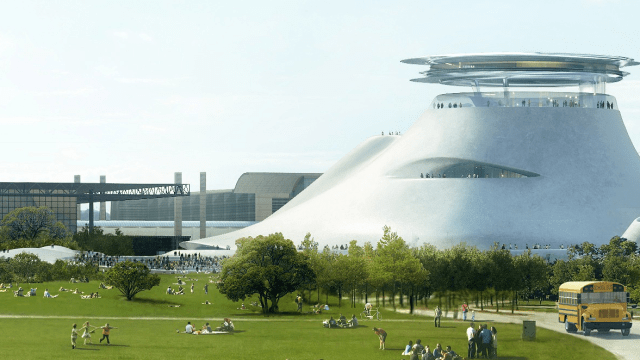A few months ago, noted traditionalist George Lucas surprised everyone by announcing he had chosen the avant-garde architect Ma Yansong to design his Museum of Narrative Art. Today in Chicago, we got a first look at what Lucas and Ma have in mind — and it could transform Chicago’s lakeshore.
When George Lucas announced he’d be building his museum in Chicago, fans were shocked — why not San Francisco, where Lucas has built his earthly empire? It’s unclear exactly what went wrong with San Francisco’s bid to host the museum, but it likely had something to do with its rejection of Lucas’ first proposed site. Chicago, on the other hand, offered up what is possibly the city’s most prime cut of real estate on a silver platter: 17 acres of lakefront next to Soldier Field, within walking distance of some of the city’s biggest tourist attractions. Bingo.
San Francisco, meanwhile, developed a serious case of sour grapes, with the Business Times‘ Chris Rauber calling Chicago mayor Rahm Emanuel “a foul-mouthed Darth Vader, calling in favours and threatening harm to those who stand in his path.”
Whatever your opinion of Chicago, Darth Vader — and Rahm — could get shit done. And today, only a few months after Lucas chose Chicago, the project team introduced the first renderings of the building. In a suite at the Waldorf Astoria in Chicago, the Beijing-based architect Ma Yansong walked me through his vision for the building, which will stretch over a long piece of lakefront between the city and Lake Michigan.
The Lucas Museum of Narrative Art looks less like an art museum and more like a college campus from some imagined future: A long, stately procession of small parklets and public spaces kept in order by an organic knot of sidewalks paved in light grey stone, which rises up to become the facade of the building itself, a sinuous white mass of conical forms that house the museum, along with four theatres, an education center, archival space, and more, totaling about 400,000 square feet.
It’s less of a building than a sponge, a sticky substance that curves through the lakefront and carves out buildings, parks, and sidewalks where it wants them. The idea, Ma told me today, was to turn an area that feels like a warren of parking and backstreets into useable public space. “This should be a successful public park,” he said. “Right now, it’s parking.” It rises up to cover a parking lot and through-street, then dips down to create an outdoor amphitheater for screenings.
It rises back up to form the mass of the museum itself, a conical space with a circular plan that looks a lot like Frank Lloyd Wright’s iconic Guggenheim Museum. Visitors will enter the museum and see a huge, naturally-lit white cone, the walk upwards through gallery spaces until they arrive at a metallic 360-degree observation deck and restaurant, which will be free to the public to visit — a “new way to view the city,” says the architect.
If it looks like a super-sized version of a creature you might find swilling a drink at the Mos Eisley Cantina, it’s entirely coincidental. The museum will include some Star Wars art, but most of its collection will be unrelated to Lucas’ most famous films, including everything from Norman Rockwell paintings to MAD Magazine cover art. But as Ma put it today, the design does have something in common with classic films like Star Wars. “Historically, sci-fi movies have played an important role in inspiring young people,” he said. “That’s the goal of this museum, as well.”
How Chicagoans will react to this alien of a building remains to be seen, but it’s worth pointing out the city’s progressive take on contemporary architecture throughout history, from the Aqua Tower to the Marina Towers. Not to mention Mies van der Rohe, who you might describe as the patron saint of Chicago architecture (alongside Burnham and Root, of course), and who impressed a deeply rational logic on the downtown. But as Ma — who worked as an intern architect in Chicago before founding his own firm — pointed out today, “even Mies was alien to Chicago” at one point. In the end, his Bauhaus-era ideas came to define the city.
Ma and his collaborators — still have a long ways to go before these early ideas are made real. Now the team will go into schematic design and, next spring, present a final proposal to the city. In the meantime, the museum still needs to pick an Executive Director and get its ducks in a row, not to mention convince preservationists and critics who argue that the project is “ill-conceived” and possibly illegal. But considering that Lucas chose a place and an architect for his museum within the span of just a few months, we might be hearing more very soon.
